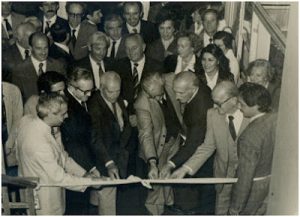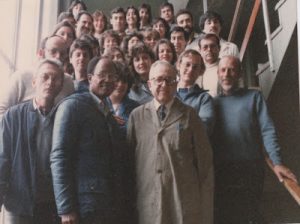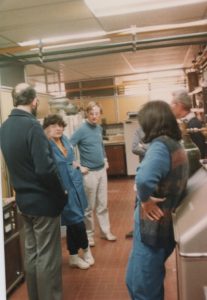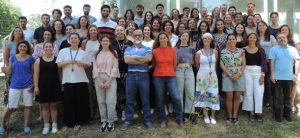Origins
The Biological Research Institute (IIB) emerged as an initiative of Dr. Horacio Pontis, who had been director of the Biology Department of the Bariloche Foundation. This institution was created in 1963 from the efforts of a group of Balseiro scientists and entrepreneurs committed to the dissemination of scientific knowledge and the cultivation of the arts. It was constituted as an alternative work for scientists after the military coup of 1966, under the full support of academic freedom in the different areas of knowledge.
From 1976, the experience of the Bariloche Foundation was interrupted by the civil-military dictatorship due to a virtually total disfinancing. The institution depended on the contributions provided annually by the National State and at that time the self-proclaimed National Reorganization Process made it a condition for the dismissal of certain researchers and the subordination of the contents of the investigations to the authorization of the military government. As the institution did not accept these conditions, many of its researchers were persecuted and at the end of the same year it had to dispose of land they had acquired to build a campus in order to compensate all staff. In the years that followed, the Foundation was reduced to 15 people, with researchers who decided to take the risk of continuing to use the funds of the respective indemnities.
From this reality, the option of moving the laboratories and library of the Foundation’s Biology Department to another location was considered. While searching for the right place, Dr. Pontis and his wife, Dr. Graciela Salerno, as well as other researchers working there, migrated abroad.
The decision to choose the new place was not easy, in principle there were three possibilities: Salta, Tandil or Mar del Plata, but finally the latter was chosen for having a young university and being close to an agricultural region and facing the sea. In addition to its rector, Dr. Navarro was particularly interested in bringing researchers to the university to improve the level of the biology degree. At that time Mar del Plata had the Research Institute in Marine Biology (IIBM) dependent on the University of Buenos Aires (UBA), inserted in the recently created National Institute of Fisheries Research and Development (INIDEP) of important tradition in research on the Argentine sea.
 The National University of Mar del Plata (UNMdP) had a Faculty of Natural and Exact Sciences and a Biology degree that had begun to be taught at the facilities of the Secondary School N° 1 (better known as "La Piloto", located in Maipú and Marconi streets), also in the IIBM and the National Institute of Epidemiology (INE). From 1979, when the current university complex began to be built in the building of Funes and San Lorenzo, it began to be dictated there. In that building it was also thought to create a Department of Functional Biology dependent on the incipient Faculty of Natural and Exact Sciences, however this idea did not prosper and merged to the existing Department of Biology that would later move to the new building.
The National University of Mar del Plata (UNMdP) had a Faculty of Natural and Exact Sciences and a Biology degree that had begun to be taught at the facilities of the Secondary School N° 1 (better known as "La Piloto", located in Maipú and Marconi streets), also in the IIBM and the National Institute of Epidemiology (INE). From 1979, when the current university complex began to be built in the building of Funes and San Lorenzo, it began to be dictated there. In that building it was also thought to create a Department of Functional Biology dependent on the incipient Faculty of Natural and Exact Sciences, however this idea did not prosper and merged to the existing Department of Biology that would later move to the new building.
In 1979 the construction of the IIB began in what was the terrace of the building of Funes and San Lorenzo. Meanwhile, Dr. Pontis contacted former collaborators of the Bariloche Foundation, among them Dr. Pont Lezica; Dr. Conde, who was working in the Faculty of Pharmacy and Biochemistry of the UBA; Dr. Daleo, in the United States doing a postdoctoral stay; Dr. Augusto "Chicho" García, who had been director of the Biology Department of the Foundation; Dr. Norma Kerber and Dr. Norma Pucheu, among others.
In addition to the construction of the Institute and the Department, the University had undertaken to fund the new research groups. That same year the Foundation for Applied Biological Research (FIBA) was created, like the Campomar Foundation that was born by the Nobel prize of Dr. Luis Federico Leloir. Half of this prize went to FIBA, which used the money to purchase all the equipment that was packed in Bariloche.
Negotiations with the Rector of the University, Dr. Navarro, had come to the conclusion that, first, the IIB would depend directly on the Rectorate and that the Biology Department would depend on the Faculty. The director of both would be Dr. Pontis, replacing his former director, Dr. Vega.
Beginnings of the IIB
The creation of the Institute was aimed at strengthening the Biological Sciences in Mar del Plata and training human resources in the undergraduate and postgraduate fields. At the beginning of 1981, the works had advanced and its inauguration was planned for March 19 with several high-ranking guests, including Dr. Leloir himself; the president of the Scientific Research Commission (CIC) of the Brida. of Buenos Aires, Dr. Juan J. Gagliardino; military authorities of the time and other outstanding figures of the Marplatense university orbit. On this occasion it was also founded by the Biological Research Center (CIB) under FIBA.
The IIB at that time had 400 m2, including 6 laboratories, common areas and space for an important scientific library that was brought from the Bariloche Foundation. Soon Dr. Pont Lezica arrived, who occupied Laboratories 5 and 6; Dr. Conde (Laboratory 3) and Dr. Pontis along with Dr. Salerno (Laboratories 1 and 2). A little later arrived Dr. Augusto "Chicho" García, who occupied with Dr. Pucheu Laboratory 4 of the IIB; Dr. Kerber and Dr. Daleo (Laboratories of the Biology Department). Dr. D'Antoni, Dr. Goldemberg, Dr. Vega and Dr. Patronelli.

In this way, an Institute had been formed and part of a Department that had their strengths in research in Biochemistry and Plant Physiology, especially sugars, at some point derived from Dr. Leloir’s lines of research. Research lines were also developed in animal protein metabolism and in photosynthetic microorganisms. For this reason it was decided that its name was "Biological Research" as a broad name, in order to cover different projects of all these new groups that had arrived at the University of Mar del Plata.
Both Dr. Pontis and Dr. Pont Lezica and Dr. Conde had subsidies from the CIC and there was an institutional subsidy to buy large equipment, such as Sorvall centrifuges, scintillation counter, scanner, coolers, lyophilizer, power sources, pHmeters, etc. That same year, Dr. Daleo presented from the United States his work plan to join the CIC to develop a line in plant-microorganism interaction, with emphasis on the potato plant as a model, given the regional insertion of the crop. The Institute’s teaching work at the postgraduate level included (and continues to do so) the training of young researchers undertaking doctoral theses and postgraduate courses.
In the undergraduate area, the IIB began to teach several subjects for bachelors and professorate in Biological Sciences within the area of Biological Chemistry and Molecular Biology. This marked a before and after for the incipient career of Bachelor and Faculty in Biology, with all these researchers, many of them from CONICET or the CIC who gave an important imprint of experimental science that continues to this day.
Return to democracy
The advent of democracy in December 1983 brought institutional changes, the so-called "normalization". The University and its Faculties adopted provisional governments until the different levels were formed that according to the University Reform of 1918 were necessary for a democratic election of authorities. They were to be elected by assembly, slowly awakening from the lethargy imposed by the dictatorship.
The IIB and the Department were not oblivious to these changes. A council was formed with group leaders and representatives of the fellows. Support Staff also contributed greatly to the establishment of these new groups in Mar del Plata such as María del Carmen Luciano (librarian), Clara Fernández, Carmiña Rodríguez, María Elvira Aued, Verónica Ramírez, Perlino, among others.
In 1984, a programme was opened in Biotechnology, representing a breakthrough in this emerging global issue. The Paul Hnos Scientific Institute S.A., a company from Castelar, Buenos Aires, already had contacts with FIBA and decided to finance Dr. Salerno to attend congresses and laboratories in Europe in order to acquire knowledge and then to gestate a postgraduate course on this new area, so that it could develop it in the country. He was able to invite the prestigious professor Van Montagu from Belgium, who had managed to transform plants, to give talks at the IIB and the University.

Thus, in 1986 took place the first postgraduate course in Plant Molecular Biology organized by Dr. Salerno with outstanding teachers worldwide and had students from all over the country as well as other countries in South America. It took place for four intensive weeks with a very positive result for the scientists of the Institute and the career. In the same year, a course on Molecular Biology was given at undergraduate and postgraduate level coordinated by Dr. Salerno with teachers from the UBA attended by several students in training who were either part of the IIB or then entered as Silvina Santoiani, Marcela Pinedo and Eduardo Zabaleta, among others.
In 1985, the Drs. Daleo and D'Antoni promoted from the Biology Department a change of curriculum of the degree in Biology that would replace the previous one of 1981. This change involved a basic cycle with General Physiology, a strong training component in experimental reasoning and then an upper cycle of eight electives with the possibility of pursuing biology majors throughout the country. This plan of electives had to be supervised by a tutor and abandoned the rigidity of the previous plan with well-defined, dynamic, flexible and transversal orientations that radically changed the profile of the graduates.
In 1987, an international student, Dr. Martin Crespi, entered Dr. Pontis' laboratory after a short stay at CINVESTAV in Irapuato, Mexico, with Dr. Luis Herrera-Estrella. The latter was very famous for having made the first transgenic tobacco plant in 1983 in Belgium. Martin’s project on the cloning of wheat sucrose phosphate synthase (SPS), an important enzyme for sucrose synthesis, was one of the first to include Molecular Biology in the IIB. When Martin Crespi emigrated to Belgium in late 1988, Dr. Eduardo Zabaleta inherited this project.
During that year, the country was facing serious economic problems with the failure of President Alfonsín’s southern plan, after the painted-face uprising at Easter. Dr. Pont Lezica emigrated to Saint Louis, Missouri, United States although he continued to direct his fellows from abroad. In 1988, he decided to emigrate to France, settling permanently in Toulouse. There were also clear differences between researchers belonging to the CIB and those belonging only to the IIB, and in September of that year an agreement was signed on how the teams and drugs would be divided in the face of a possible separation and removal.
 A third cohort of undergraduate and graduate students entered the various laboratories: Silvia Goicoechea, Marta Sabas, Lourdes Tabares and Carmen Segarra with Dr. Conde, Eduardo Herrera, Claudia Studdert with Dr. Salerno and Dr. Crespi, Gabriela Pujol with Dr. Garcia, Roberto Paggi with Dr. Kerber and Claudia Tonón for a bachelor’s thesis and then PhD with Dr. Daleo.
A third cohort of undergraduate and graduate students entered the various laboratories: Silvia Goicoechea, Marta Sabas, Lourdes Tabares and Carmen Segarra with Dr. Conde, Eduardo Herrera, Claudia Studdert with Dr. Salerno and Dr. Crespi, Gabriela Pujol with Dr. Garcia, Roberto Paggi with Dr. Kerber and Claudia Tonón for a bachelor’s thesis and then PhD with Dr. Daleo.
Meanwhile, Lorenzo Lamattina, after his doctorate in 1987 (he was the first Doctor of the FCEyN and the UNMdP) obtained a postdoctoral position and in February 1988 moved to Strasbourg, France, at the Institut de Biologie Moléculaire des Plantes (IBMP). In the laboratory of Dr. Grienenberger, he discovered simultaneously with other researchers in laboratories in Germany and Canada, the process of editing RNA messengers in mitochondria. The results of this research were published in the journal Nature. Although Lorenzo appears as the second author to give rise to a doctorate that required publication, Lorenzo had had the idea of the process. Fact that, to mark 20 years of the discovery, Dr. Grienenberger himself recognized in a review saying that the first authorship should have been shared, practice that was not stylized at the time.
Claudia Casalongué defended her doctoral thesis at the end of 1988. Despite the migration of its director, Dr. Pont Lezica, to the United States, he was able to spend some months in his laboratory abroad to complete his thesis work. There Claudia did the first experiments in Molecular Biology with the aim of cloning the potato lectin gene.
IIB-FIBA divided
 In February 1989, the IIB-UNMdP and CIB-FIBA were separated. The latter moved to a rented building on Estado de Israel Street where a Hematological Foundation operated. Initially, Drs. García, Kerber and Pucheu were to be part of CIB-FIBA. However, due to disagreements they had already decided in 1988 to move to Buenos Aires, leaving their fellows in the IIB until the completion of their thesis. There were some attempts to remain in the IIB but negotiations were unsuccessful. Therefore, Dr. Pontis' and Dr. Salerno's laboratories moved completely with the entire library that came from the Bariloche Foundation, much of the equipment, part of the furniture and half of the chemical reagents.
In February 1989, the IIB-UNMdP and CIB-FIBA were separated. The latter moved to a rented building on Estado de Israel Street where a Hematological Foundation operated. Initially, Drs. García, Kerber and Pucheu were to be part of CIB-FIBA. However, due to disagreements they had already decided in 1988 to move to Buenos Aires, leaving their fellows in the IIB until the completion of their thesis. There were some attempts to remain in the IIB but negotiations were unsuccessful. Therefore, Dr. Pontis' and Dr. Salerno's laboratories moved completely with the entire library that came from the Bariloche Foundation, much of the equipment, part of the furniture and half of the chemical reagents.
The whole division was in charge of both the researchers and the fellows. It was a very distressing time for everyone. People who many years ago were companions were suddenly in separate institutes and had to divide all the reagents of a very nourished and complete druggist, packing up those that were leaving and making catalogues of those that were staying so that everything was done with the greatest order and clarity possible. It was a time in Argentina in wich the economy was beginning to falter and therefore funding for science was going to be scarce. The IIB remained virtually empty and with many difficulties to continue operating. Several of the fellows who were still doing their thesis thought that the Institute could close its doors, such was the atmosphere then in the halls of the institute.
Now
On 27 December 2006, CONICET and the National University of Mar del Plata signed an agreement on reciprocal complementarity (OCS 2201/07) and within that framework the creation of the Biological Research Institute (IIB) was approved as a dual-unit Executing Unit, CONICET-UNMdP.
Currently, the Biological Research Institute (IIB) is located in the university complex (Funes 3250, 4th level) and has more than 100 researchers dedicated to basic and applied research in biological sciences. Due to its strategic location between the sea and the countryside, it carries out projects that integrate the marine genetic pool with agricultural production from a biochemical, bioinformatic and Cellular and Molecular Biology point of view. It also includes a strong research in plants with the objective of improving agronomic characters, research in Environmental Microbiology of extreme organisms important in the industry and studies on gametes in animals and plants to improve reproduction.
Since its inception, the IIB has shown a strong commitment to the scientific formation of HR of excellence in the field of undergraduate and postgraduate university education through activities of research, transfer, teaching, extension and management, training researchers and teachers capable of maintaining a high national and international competitive level in the field of Biological Sciences.
The former director of the IIB, Dr. Lorenzo Lamattina, received in 2019 the prestigious National Researcher Award, the important Houssay Lifetime Achievement Award, the Konex Award in 2013, the Bunge & Born Award in 2006 and the Guggenheim Award in 2005, among others. In adition, Dr. Gabriela Pagnussat stood out in the United States and has received international grants. It was part of the repatriation policy of scientists and became the only Argentine among the 28 young scientists from 12 countries who were chosen to receive the Award for Early Careers from the "Howard Hughes" Medical Institute (IMHH) in the United States. In 2023, Dr. Ana Laxalt was recognized as a Mention in the "Prize" category of the L'Oréal-UNESCO National Prize "For Women in Science".
